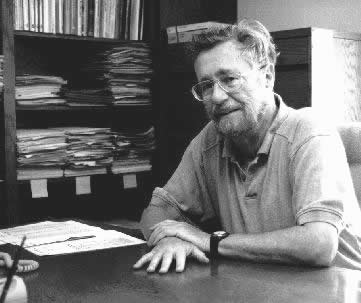Edsger Wybe Dijkstra


the core of this page is based on Mike Nussdorfer's page
|
principal papers hardware software
keywords
see also
related subjects |
Achievement In 1968 Edsger Dijkstra(7) laid the foundation stone in the march towards creating structure in the domain of programming by writing, not a scholarly paper on the subject, but instead a letter to the editor entitled "GO TO Statement Considered Harmful". (Comm. ACM, August 1968) The movement to develop reliable software was underway. Dijkstra in one of his papers: My area of interest focuses on the streamlining of the mathematical argument so as to increase our powers of reasoning, in particular, by the use of formal techniques.
Biography Edsger Wybe Dijkstra was born in Rotterdam, Netherlands in 1930. Both of his parents were intellectual people and had received good educations. His father was a chemist, and his mother was a mathematician. In 1942, when Dijkstra was 12 years old he entered the Gymnasium Erasminium, a high school for extremely bright students, and he was educated in a number of different subjects including: Greek, Latin, French, German, English, biology, mathematics, and chemistry. In 1945, Dijkstra thought that he might study law and possibly serve as a representative for the Netherlands at the United Nations. However, due to the fact that he had scored so well in chemistry, mathematics, and physics, he entered the University of Leiden, where he decided to study theoretical physics. He went to summer school on the subject of programming at Cambridge University, during the summer of 1951. He began part-time work at the Mathematical Centre in Amsterdam in March 1952, which further helped fuel his growing interest in programming. He finished the requirements for his theoretical physics degree as quickly as possible and began to pursue his interests in progamming. One of the problems that he ran into, however was that programming still was not officially recognized as a profession. In fact, when he applied for a marriage license in 1957, he had to put down "theoretical physicist" as his profession. Dijkstra continued to work at the Mathematical Centre until he accepted a job as a research fellow for Burroughs Corporation, in the United States, in the early 1970s. He was awarded the ACM Turing Award in 1972. He was given the AFIPS Harry Goode Memorial Award in 1974. Dijkstra moved to Austin, Texas in the early 1980s. In 1984 he was appointed to a chair in Computer Science at the University of Texas, Austin, where he has been ever since. Contributions
to Computer Science: In 1956, Dijkstra came up with the "shortest-path algorithm", after he had been assigned the task of showing the powers of ARMAC, the computer that the Mathematical Centre had in it's possession; an algorithm which aids in finding the best way to travel between two points. He also used this to solve the problem of finding a way to "convey electricity to all essential circuits, while using as little expensive copper wire as possible" that the engineers that had designed the ARMAC ran into. He called it the "shortest subspanning tree algorithm." In the early 1960s, Dijkstra applied the idea of mutual exclusion to communications between a computer and its keyboard. He used the letters P and V to represent the two operations that go on in the mutual exclusion problem. This idea has become a part of pretty much all, modern processors and memory board since 1964, when IBM first used it in its 360 architecture. The next problem that computer engineers must deal with that Dijkstra recognized was the "dining philosophers problem." In this problem, five philosophers are sitting at a table with a bowl of rice and a chopstick on either side of the bowl. The problem that arises is how the philosophers will be able to eat without coming to a "deadlock", ending up in a "starvation" situation, or a situation with "lack of fairness." He helped make the computer software industry a lot more disciplined by using one phrase: "GO TO considered harmful. This means that the more GO TO statements there are in a program the harder it is to follow the program's source code.
Chronology 1942 Gymnasium Erasminium 1945 Entered the University of Leiden, Netherlands to study theoretical physics. 1951 Summer school (Camebridge University) on the subject programmingelectronic computing devices, given by M.V. Wilkes Masters in Mathematics and Physics, Leiden, NL 1952 Began part-time work at the Mathematical Centre in Amsterdam in March 1956 PhD Theoretical Physics, Leiden, NL Dijkstra came up with the "shortest-path algorithm" 1957 Married to 1959 PhD University of Amsterdam 1960's Dijkstra let the world know: "GO TO considered harmful". 1962 Appointed to the chair of mathematics at Eindhoven University (substitute for computer sciences) 1973 Accepted a job as a research fellow for Burroughs Corporation, in the United States 1984 Appointed to the Schlumberger Centennial Chair in Computer Science at the University of Texas, Austin
1999 Professor Emiritus 2000 Retirement 2002 April back to the Netherlands August 8, died of cancer, leaves wife
Honors and Awards
|
![]()
| Last Updated on February 7, 2003 | For suggestions please mail the editors |
Footnotes & References